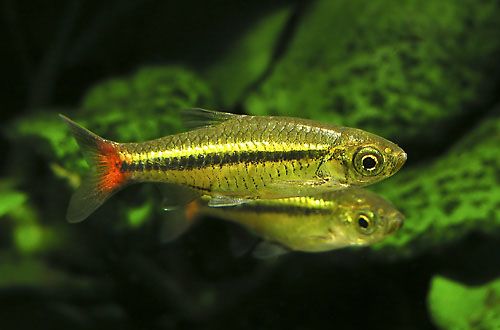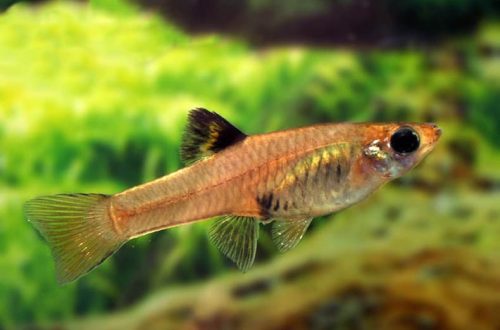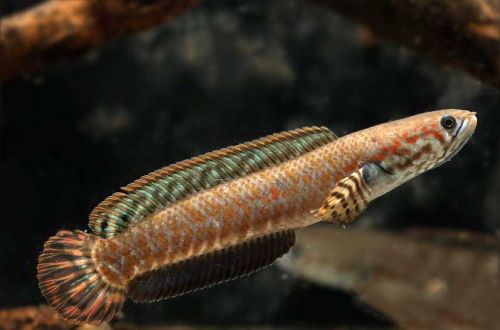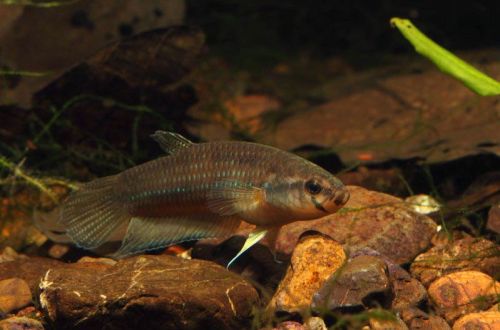
Redtail Rasbora
Red-tailed or Black-striped Rasbora, scientific name Rasbora borapetensis, belongs to the Cyprinidae family. A popular aquarium fish, unpretentious in content, compatible with many other species, and also has an original body color. All of the above makes it an excellent candidate for the role of the first fish of a novice aquarist.

Contents
Habitat
It is widely distributed throughout Southeast Asia, in particular in the territories of such modern states as Thailand (its western part), Cambodia, Laos, Vietnam, Peninsular Malaysia. It is also found in the Philippines and the greater Sunda Islands. They live in small rivers and streams with a slow current, in calm backwaters of larger rivers, ponds, and reservoirs. They successfully adapt to an increased level of pollution, so it is not uncommon for the Red-tailed Rasbora to be seen near residential villages in rice fields and ditches.
Brief information:
- The volume of the aquarium – from 100 liters.
- Temperature – 22-26°C
- Value pH — 6.0–7.5
- Water hardness – soft (2-12dGH)
- Substrate type – any
- Lighting – subdued / moderate
- Brackish water – no
- Water Movement – Low/Moderate
- The size of the fish is about 5 cm.
- Food – any food
- Temperament – peaceful, active
- Keeping in a flock of 8-10 individuals
Description
Adults reach a length of about 5 cm, females are somewhat larger, and the color is less saturated compared to males. The main color is gray, which is diluted with contrasting yellow and black horizontal stripes running along the midline. There is a bright red area at the base of the tail.
Food
Accepts all types of food for aquarium fish (dry, frozen, live). A varied diet, combining, for example, flakes and pellets with bloodworms, daphnia, has a positive effect on the general tone of the fish and their color.
Maintenance and care, arrangement of the aquarium
A flock of 10 individuals needs a tank of at least 100 liters. The choice of design is not so important, although it is noted that a dark substrate contributes to the manifestation of a more expressive coloration of the body of fish. Adding a few floating plants, along with rooted ones, as well as various driftwood will give a natural look to your tank.
Water filtration should not be intensive, as the Red-tailed Rasbora is not able to deal with strong currents. The minimum set of equipment, in addition to the filter, includes a lighting system, a heater and an aerator.
The composition of water has slightly acidic or neutral pH values with low hardness. Read more about pH and dGH parameters and how to change them in the “Hydrochemical composition of water” section.
Maintenance of the aquarium consists of a weekly replacement (10–15%) of part of the water with fresh water, regular cleaning of the soil from organic waste and glass from plaque.
Behavior and Compatibility
Peaceful flock species, content in a group of at least 8–10 individuals. It gets along well with other popular aquarium fish from among cyprinids, characins, viviparous, provided that they are comparable in size and have a similar temperament. As neighbors, you can pick up fish originating from the same range, for example, some varieties of Gourami, Danio, Barbs and other Rasboras.
Breeding / breeding
Refers to spawning species, females scatter eggs in the water column, and males at this moment fertilize it. Parental instincts are poorly developed, immediately after spawning, the fish can eat their own caviar and fry that have appeared.
Breeding is recommended to be carried out in a separate tank – a spawning aquarium, in order to protect offspring from adult fish. The design is simple, the main attention is paid to the ground, it should consist of particles of a sufficiently large size that do not fit tightly to each other, forming voids, for example, pebbles or decorative glass beads. When the eggs sink to the bottom, most of them fall into these voids and thus become inaccessible to fish. A similar effect is also achieved when using a fine mesh, which is fixed at the bottom.
Another way to ensure the preservation of eggs is to use low-growing small-leaved plants or mosses such as Riccia floating and Javanese moss, which are planted on most of the surface of the substrate (in this case, the soil can be any). Dense thickets of plants can provide reliable shelter for eggs no worse than special soil.
The size of the spawning aquarium is usually 50-70 liters. The equipment used is an aerator, a heater and a simple sponge filter of low power to prevent accidental suction of eggs and fry. Spawning occurs in dim light, so at first there is no need for a light source.
The impetus for the beginning of the mating season is the establishment of the water temperature in the region of the upper permissible marks at a slightly acidic pH value and daily feeding of protein foods (live or frozen). After some time, the females become noticeably rounder, and the males will begin to actively show signs of attention to their chosen ones. At this point, you should prepare a separate tank and fill it with water from the general aquarium, then transplant several females and the most colorful males there. Spawning can be initiated by adding cool water every few hours, thus lowering the temperature by 2-3 degrees. Females lay eggs in portions, so spawning is delayed for 4–5 days. The easiest way to determine its ending is by females – they will become slender.
The fish are returned. The fry will appear in 24-48 hours, and after another 3-4 days they will begin to swim freely. Feed with specialized micro food for juvenile aquarium fish.
Fish diseases
A balanced diet and suitable living conditions are the best guarantee against the occurrence of diseases in freshwater fish, so if the first symptoms of an illness appear (discoloration, behavior), the first thing to do is check the condition and quality of the water, if necessary, return all values to normal, and only then do treatment. Read more about symptoms and treatments in the Aquarium Fish Diseases section.





